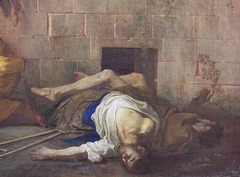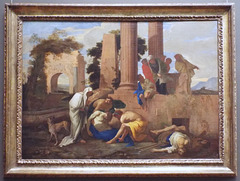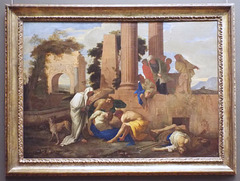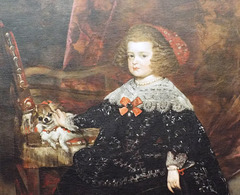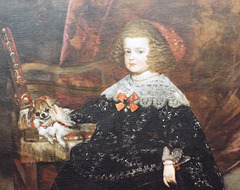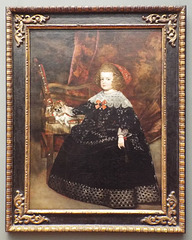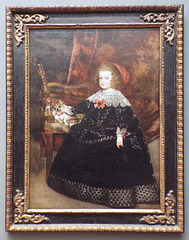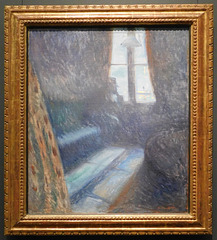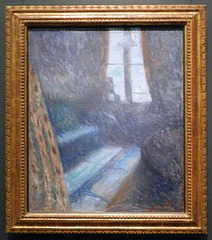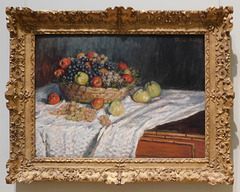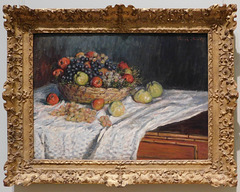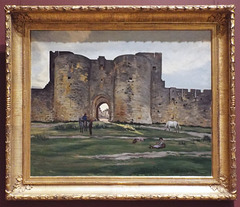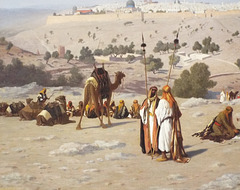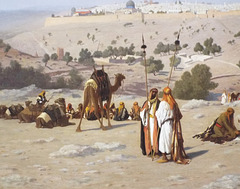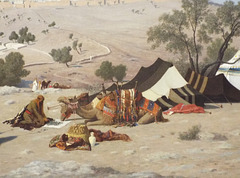LaurieAnnie's photos
Detail of Tobit Burying the Dead by DiLione in the…
| |
|
Title: Tobit Burying the Dead
Artist: Andrea di Lione (Italian, Naples 1610–1685 Naples)
Date: 1640s
Medium: Oil on canvas
Dimensions: 50 1/4 x 68 1/2 in. (127.6 x 174 cm)
Classification: Paintings
Credit Line: Gwynne Andrews Fund, 1989
Accession Number: 1989.225
In the 1640s, the Neapolitan painter Andrea di Lione visited Rome, where he met Nicolas Poussin and Giovanni Benedetto Castiglione, a painter famous for his imaginary architecture and pastoral landscapes. This work’s pronounced classicism—including the careful citation of ancient architecture and its blonde tonality—is indebted to these artists’ influence. The cloaked figure represents the Old Testament character Tobit. A devout Jew, Tobit defied an earthly decree by the local king requiring Jewish people to be buried outside the city walls in favor of divine law concerning respect for the dead.
Text from: www.metmuseum.org/art/collection/search/436891
Detail of Tobit Burying the Dead by DiLione in the…
| |
|
Title: Tobit Burying the Dead
Artist: Andrea di Lione (Italian, Naples 1610–1685 Naples)
Date: 1640s
Medium: Oil on canvas
Dimensions: 50 1/4 x 68 1/2 in. (127.6 x 174 cm)
Classification: Paintings
Credit Line: Gwynne Andrews Fund, 1989
Accession Number: 1989.225
In the 1640s, the Neapolitan painter Andrea di Lione visited Rome, where he met Nicolas Poussin and Giovanni Benedetto Castiglione, a painter famous for his imaginary architecture and pastoral landscapes. This work’s pronounced classicism—including the careful citation of ancient architecture and its blonde tonality—is indebted to these artists’ influence. The cloaked figure represents the Old Testament character Tobit. A devout Jew, Tobit defied an earthly decree by the local king requiring Jewish people to be buried outside the city walls in favor of divine law concerning respect for the dead.
Text from: www.metmuseum.org/art/collection/search/436891
Detail of Tobit Burying the Dead by DiLione in the…
| |
|
Title: Tobit Burying the Dead
Artist: Andrea di Lione (Italian, Naples 1610–1685 Naples)
Date: 1640s
Medium: Oil on canvas
Dimensions: 50 1/4 x 68 1/2 in. (127.6 x 174 cm)
Classification: Paintings
Credit Line: Gwynne Andrews Fund, 1989
Accession Number: 1989.225
In the 1640s, the Neapolitan painter Andrea di Lione visited Rome, where he met Nicolas Poussin and Giovanni Benedetto Castiglione, a painter famous for his imaginary architecture and pastoral landscapes. This work’s pronounced classicism—including the careful citation of ancient architecture and its blonde tonality—is indebted to these artists’ influence. The cloaked figure represents the Old Testament character Tobit. A devout Jew, Tobit defied an earthly decree by the local king requiring Jewish people to be buried outside the city walls in favor of divine law concerning respect for the dead.
Text from: www.metmuseum.org/art/collection/search/436891
Tobit Burying the Dead by DiLione in the Metropoli…
| |
|
Title: Tobit Burying the Dead
Artist: Andrea di Lione (Italian, Naples 1610–1685 Naples)
Date: 1640s
Medium: Oil on canvas
Dimensions: 50 1/4 x 68 1/2 in. (127.6 x 174 cm)
Classification: Paintings
Credit Line: Gwynne Andrews Fund, 1989
Accession Number: 1989.225
In the 1640s, the Neapolitan painter Andrea di Lione visited Rome, where he met Nicolas Poussin and Giovanni Benedetto Castiglione, a painter famous for his imaginary architecture and pastoral landscapes. This work’s pronounced classicism—including the careful citation of ancient architecture and its blonde tonality—is indebted to these artists’ influence. The cloaked figure represents the Old Testament character Tobit. A devout Jew, Tobit defied an earthly decree by the local king requiring Jewish people to be buried outside the city walls in favor of divine law concerning respect for the dead.
Text from: www.metmuseum.org/art/collection/search/436891
Tobit Burying the Dead by DiLione in the Metropoli…
| |
|
Title: Tobit Burying the Dead
Artist: Andrea di Lione (Italian, Naples 1610–1685 Naples)
Date: 1640s
Medium: Oil on canvas
Dimensions: 50 1/4 x 68 1/2 in. (127.6 x 174 cm)
Classification: Paintings
Credit Line: Gwynne Andrews Fund, 1989
Accession Number: 1989.225
In the 1640s, the Neapolitan painter Andrea di Lione visited Rome, where he met Nicolas Poussin and Giovanni Benedetto Castiglione, a painter famous for his imaginary architecture and pastoral landscapes. This work’s pronounced classicism—including the careful citation of ancient architecture and its blonde tonality—is indebted to these artists’ influence. The cloaked figure represents the Old Testament character Tobit. A devout Jew, Tobit defied an earthly decree by the local king requiring Jewish people to be buried outside the city walls in favor of divine law concerning respect for the dead.
Text from: www.metmuseum.org/art/collection/search/436891
Detail of Maria Teresa, Infanta of Spain by Mazo i…
| |
|
Title: María Teresa (1638–1683), Infanta of Spain
Artist: Juan Bautista Martínez del Mazo (Spanish, Cuenca ca. 1612–1667 Madrid)
Date: ca. 1645
Medium: Oil on canvas
Dimensions: 58 1/4 x 40 1/2 in. (148 x 102.9 cm)
Classification: Paintings
Credit Line: Rogers Fund, 1943
Accession Number: 43.101
Mazo was Velázquez’s assistant and son-in-law, having married his daughter Francisca in 1633, and he mimicked many of the elder artist’s techniques and formats. Here, he portrays María Teresa, daughter of King Philip IV of Spain and future queen of France, at around seven years old. Though she wears a rigid court dress, her lapdog lends the painting an informality typical of Velázquez’s innovative portraits of royal children. The putti faintly visible through the red curtain at upper right reveal that Mazo reused a canvas once painted with an entirely different composition, a common practice in even the highest-level workshops.
Text from: www.metmuseum.org/art/collection/search/437046
Detail of Maria Teresa, Infanta of Spain by Mazo i…
| |
|
Title: María Teresa (1638–1683), Infanta of Spain
Artist: Juan Bautista Martínez del Mazo (Spanish, Cuenca ca. 1612–1667 Madrid)
Date: ca. 1645
Medium: Oil on canvas
Dimensions: 58 1/4 x 40 1/2 in. (148 x 102.9 cm)
Classification: Paintings
Credit Line: Rogers Fund, 1943
Accession Number: 43.101
Mazo was Velázquez’s assistant and son-in-law, having married his daughter Francisca in 1633, and he mimicked many of the elder artist’s techniques and formats. Here, he portrays María Teresa, daughter of King Philip IV of Spain and future queen of France, at around seven years old. Though she wears a rigid court dress, her lapdog lends the painting an informality typical of Velázquez’s innovative portraits of royal children. The putti faintly visible through the red curtain at upper right reveal that Mazo reused a canvas once painted with an entirely different composition, a common practice in even the highest-level workshops.
Text from: www.metmuseum.org/art/collection/search/437046
Maria Teresa, Infanta of Spain by Mazo in the Metr…
| |
|
Title: María Teresa (1638–1683), Infanta of Spain
Artist: Juan Bautista Martínez del Mazo (Spanish, Cuenca ca. 1612–1667 Madrid)
Date: ca. 1645
Medium: Oil on canvas
Dimensions: 58 1/4 x 40 1/2 in. (148 x 102.9 cm)
Classification: Paintings
Credit Line: Rogers Fund, 1943
Accession Number: 43.101
Mazo was Velázquez’s assistant and son-in-law, having married his daughter Francisca in 1633, and he mimicked many of the elder artist’s techniques and formats. Here, he portrays María Teresa, daughter of King Philip IV of Spain and future queen of France, at around seven years old. Though she wears a rigid court dress, her lapdog lends the painting an informality typical of Velázquez’s innovative portraits of royal children. The putti faintly visible through the red curtain at upper right reveal that Mazo reused a canvas once painted with an entirely different composition, a common practice in even the highest-level workshops.
Text from: www.metmuseum.org/art/collection/search/437046
Maria Teresa, Infanta of Spain by Mazo in the Metr…
| |
|
Title: María Teresa (1638–1683), Infanta of Spain
Artist: Juan Bautista Martínez del Mazo (Spanish, Cuenca ca. 1612–1667 Madrid)
Date: ca. 1645
Medium: Oil on canvas
Dimensions: 58 1/4 x 40 1/2 in. (148 x 102.9 cm)
Classification: Paintings
Credit Line: Rogers Fund, 1943
Accession Number: 43.101
Mazo was Velázquez’s assistant and son-in-law, having married his daughter Francisca in 1633, and he mimicked many of the elder artist’s techniques and formats. Here, he portrays María Teresa, daughter of King Philip IV of Spain and future queen of France, at around seven years old. Though she wears a rigid court dress, her lapdog lends the painting an informality typical of Velázquez’s innovative portraits of royal children. The putti faintly visible through the red curtain at upper right reveal that Mazo reused a canvas once painted with an entirely different composition, a common practice in even the highest-level workshops.
Text from: www.metmuseum.org/art/collection/search/437046
Night in Saint-Cloud by Munch in the Metropolitan…
| |
|
Title: Night in Saint-Cloud
Artist: Edvard Munch (Norwegian, Løten 1863–1944 Ekely)
Date: 1893
Medium: Oil on canvas
Dimensions: 27 9/16 x 22 5/16 in. (70 x 56.7 cm)
Classification: Paintings
Credit Line: Private collection
Accession Number: L.2018.2
Munch first undertook this composition in 1890 (Nasjonalmuseet, Oslo), while living in the Parisian suburb of Saint-Cloud. His friend, the Danish poet Emanuel Goldstein, posed for the enigmatic top-hatted figure silhouetted in the moonlight. The melancholy mood has been related to the recent death of Munch’s father, but the scene seems to have held broader significance for the artist. He repeated it several times in different media; this version was painted in 1893, in Berlin, at a time when he made a number of nocturnal window scenes, notable for their intimate atmosphere and evocative light effects.
Text from: www.metmuseum.org/art/collection/search/441924
Night in Saint-Cloud by Munch in the Metropolitan…
| |
|
Title: Night in Saint-Cloud
Artist: Edvard Munch (Norwegian, Løten 1863–1944 Ekely)
Date: 1893
Medium: Oil on canvas
Dimensions: 27 9/16 x 22 5/16 in. (70 x 56.7 cm)
Classification: Paintings
Credit Line: Private collection
Accession Number: L.2018.2
Munch first undertook this composition in 1890 (Nasjonalmuseet, Oslo), while living in the Parisian suburb of Saint-Cloud. His friend, the Danish poet Emanuel Goldstein, posed for the enigmatic top-hatted figure silhouetted in the moonlight. The melancholy mood has been related to the recent death of Munch’s father, but the scene seems to have held broader significance for the artist. He repeated it several times in different media; this version was painted in 1893, in Berlin, at a time when he made a number of nocturnal window scenes, notable for their intimate atmosphere and evocative light effects.
Text from: www.metmuseum.org/art/collection/search/441924
Apples and Grapes by Monet in the Metropolitan Mus…
| |
|
Title: Apples and Grapes
Artist: Claude Monet (French, Paris 1840–1926 Giverny)
Date: 1879–80
Medium: Oil on canvas
Dimensions: 26 5/8 x 35 1/4 in. (67.6 x 89.5 cm)
Classification: Paintings
Credit Line: Gift of Henry R. Luce, 1957
Accession Number: 57.183
This is one of three tabletop still lifes depicting a basket of apples and grapes that Monet painted in 1879–80, when a spell of bad weather forced him to retreat indoors. In late November 1879, his future stepdaughter Marthe Hoschedé took note of a "painting of fruits" in progress, when she recorded that Monet was "working hard at his still lifes which are very pretty."
Text from: www.metmuseum.org/art/collection/search/437130
Apples and Grapes by Monet in the Metropolitan Mus…
| |
|
Title: Apples and Grapes
Artist: Claude Monet (French, Paris 1840–1926 Giverny)
Date: 1879–80
Medium: Oil on canvas
Dimensions: 26 5/8 x 35 1/4 in. (67.6 x 89.5 cm)
Classification: Paintings
Credit Line: Gift of Henry R. Luce, 1957
Accession Number: 57.183
This is one of three tabletop still lifes depicting a basket of apples and grapes that Monet painted in 1879–80, when a spell of bad weather forced him to retreat indoors. In late November 1879, his future stepdaughter Marthe Hoschedé took note of a "painting of fruits" in progress, when she recorded that Monet was "working hard at his still lifes which are very pretty."
Text from: www.metmuseum.org/art/collection/search/437130
Porte de la Reine by Bazille in the Metropolitan M…
| |
|
Title: Porte de la Reine at Aigues-Mortes
Artist: Jean-Frédéric Bazille (French, Montpellier 1841–1870 Beaune-la-Rolande)
Date: 1867
Medium: Oil on canvas
Dimensions: 31 3/4 x 39 1/4 in. (80.6 x 99.7 cm)
Classification: Paintings
Credit Line: Purchase, Gift of Raymonde Paul, in memory of her brother, C. Michael Paul, by exchange, 1988
Accession Number: 1988.221
During the late spring of 1867 Bazille visited the town of Aigues-Mortes near his family home in Montpellier. Hoping for "at least eight beautiful days," he set himself the challenge of painting "absolutely simple" landscapes of the city and surrounding marshes. Of the artist’s three known views of the area, this is the only one to show the massive medieval walls of Aigues-Mortes from up close. It also displays the most striking light effects: the southern sun shines brightly through the archway, contrasting with the afternoon shadows that envelop the grazing Camargue pony and the figures in the foreground.
Text from: www.metmuseum.org/art/collection/search/435626
Porte de la Reine by Bazille in the Metropolitan M…
| |
|
Title: Porte de la Reine at Aigues-Mortes
Artist: Jean-Frédéric Bazille (French, Montpellier 1841–1870 Beaune-la-Rolande)
Date: 1867
Medium: Oil on canvas
Dimensions: 31 3/4 x 39 1/4 in. (80.6 x 99.7 cm)
Classification: Paintings
Credit Line: Purchase, Gift of Raymonde Paul, in memory of her brother, C. Michael Paul, by exchange, 1988
Accession Number: 1988.221
During the late spring of 1867 Bazille visited the town of Aigues-Mortes near his family home in Montpellier. Hoping for "at least eight beautiful days," he set himself the challenge of painting "absolutely simple" landscapes of the city and surrounding marshes. Of the artist’s three known views of the area, this is the only one to show the massive medieval walls of Aigues-Mortes from up close. It also displays the most striking light effects: the southern sun shines brightly through the archway, contrasting with the afternoon shadows that envelop the grazing Camargue pony and the figures in the foreground.
Text from: www.metmuseum.org/art/collection/search/435626
Detail of Jerusalem from the Mount of Olives by Fr…
| |
|
Title: Jerusalem from the Mount of Olives
Artist: Charles-Théodore Frère (French, Paris 1814–1888 Paris)
Date: by 1880
Medium: Oil on canvas
Dimensions: 29 1/2 x 43 1/2 in. (74.9 x 110.5 cm)
Classification: Paintings
Credit Line: Catharine Lorillard Wolfe Collection, Bequest of Catharine Lorillard Wolfe, 1887
Accession Number: 87.15.106
This panoramic view was commissioned from Frère by the New York collector Catharine Lorillard Wolfe by 1880, when it was first described as being in her possession. Because the artist had not been to the Holy Land for twenty years—he had last traveled there as part of Empress Eugénie’s retinue in 1861—the composition must be based on one or more earlier studies or photographs.
Text from: www.metmuseum.org/art/collection/search/436418
Detail of Jerusalem from the Mount of Olives by Fr…
| |
|
Title: Jerusalem from the Mount of Olives
Artist: Charles-Théodore Frère (French, Paris 1814–1888 Paris)
Date: by 1880
Medium: Oil on canvas
Dimensions: 29 1/2 x 43 1/2 in. (74.9 x 110.5 cm)
Classification: Paintings
Credit Line: Catharine Lorillard Wolfe Collection, Bequest of Catharine Lorillard Wolfe, 1887
Accession Number: 87.15.106
This panoramic view was commissioned from Frère by the New York collector Catharine Lorillard Wolfe by 1880, when it was first described as being in her possession. Because the artist had not been to the Holy Land for twenty years—he had last traveled there as part of Empress Eugénie’s retinue in 1861—the composition must be based on one or more earlier studies or photographs.
Text from: www.metmuseum.org/art/collection/search/436418
Detail of Jerusalem from the Mount of Olives by Fr…
| |
|
Title: Jerusalem from the Mount of Olives
Artist: Charles-Théodore Frère (French, Paris 1814–1888 Paris)
Date: by 1880
Medium: Oil on canvas
Dimensions: 29 1/2 x 43 1/2 in. (74.9 x 110.5 cm)
Classification: Paintings
Credit Line: Catharine Lorillard Wolfe Collection, Bequest of Catharine Lorillard Wolfe, 1887
Accession Number: 87.15.106
This panoramic view was commissioned from Frère by the New York collector Catharine Lorillard Wolfe by 1880, when it was first described as being in her possession. Because the artist had not been to the Holy Land for twenty years—he had last traveled there as part of Empress Eugénie’s retinue in 1861—the composition must be based on one or more earlier studies or photographs.
Text from: www.metmuseum.org/art/collection/search/436418

